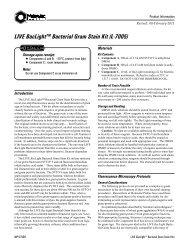Vertical Vegetation Structure Below Ground: Scaling from Root
Vertical Vegetation Structure Below Ground: Scaling from Root
Vertical Vegetation Structure Below Ground: Scaling from Root
You also want an ePaper? Increase the reach of your titles
YUMPU automatically turns print PDFs into web optimized ePapers that Google loves.
<strong>Vertical</strong> <strong>Vegetation</strong> <strong>Structure</strong> <strong>Below</strong> <strong>Ground</strong>: <strong>Scaling</strong> <strong>from</strong> <strong>Root</strong> to Globe 363Based on this line of reasoning,it may be postulated that vertical rootdistributions of communities will tend to approach shapes that maximizewater and nutrient use efficiency at the community scale. This developmentwill be driven by plastic root growth in response to environmental conditions,positiveand negative species interactions,the resulting niche partitioningof the soil profile,successional changes in species composition,andby positive feedback effects. One may further predict that root distributionsafter major disturbances and in early successional or species-poor communitiesare less likely to approach optimal resource use efficiency and aremore likely to be restricted to shallow soil layers which usually offer thegreatest amount of resources at the lowest cost to plants (Gale and Grigal1987).These ideas about resource use optimization at the community levelwere the basis for a conceptual model of global rooting depths (Schenk andJackson 2002b),which was based on the observation that many of thevariables shaping vertical root distributions (see Table 2) tend to favorshallow roots over deep roots: (1) energy costs for construction,maintenance,andresource uptake are lower for shallow roots; (2) water in mostsoils enters the profile predominantly <strong>from</strong> above; (3) nutrient concentrationsare typically highest in the upper soil layers; (4) shallow soil layers areusually less likely to be oxygen-deficient; and (5), because of reasons(1)–(4),shallow roots generally have competitive advantages over deeperroots. Based on this conceptual model,rooting depths should only increaseif (1) there is transpirational demand for water that cannot be fulfilled bytaking up water stored closer to the soil surface and (2) water is available atdepth. Therefore,average rooting depths are predicted to be shallow in coldenvironments due to low transpirational demand,shallow in dry environmentsregardless of the thermal regime because of a general lack of waterat depth,shallow in per-humid environments because deep roots are notneeded there to fulfill transpirational demands,and deep in warm andseasonally dry environments because of high transpirational demands andthe availability of deep soil water. Analyses of large data sets of rootingdepths <strong>from</strong> dry environments (Schenk and Jackson 2002b) and <strong>from</strong> abroad range of global environments (Schenk and Jackson 2004) stronglysupport these general trends (Fig. 6),thereby allowing the predictions forthe global distribution of deep roots depicted in Fig. 7. Much furtherresearch will be required to test the validity of the assumptions underlyingthe conceptual model of Schenk and Jackson (2002b),to test the accuracyof the global map in Fig. 7,and to develop process-based mathematicalmodels that can increase the accuracy of predictions.
















